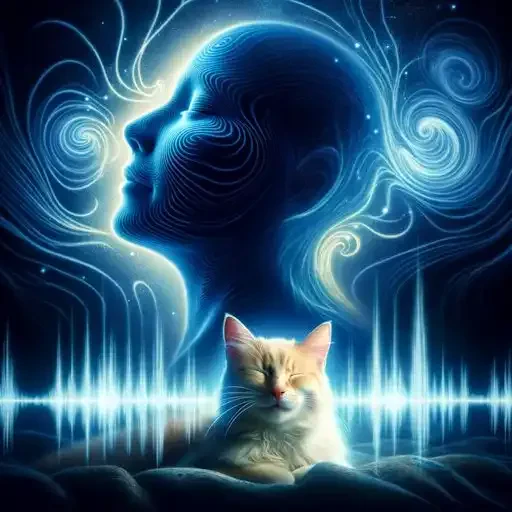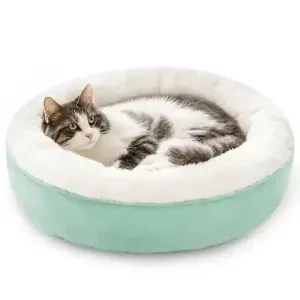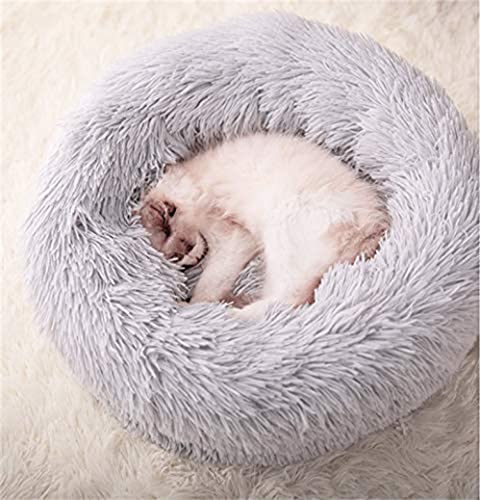Twitching paws, fluttering whiskers, soft, almost inaudible mews escaping slumbering lips – anyone who has ever been captivated by the peaceful sight of a sleeping cat has likely found their mind drifting to a fascinating question: what exactly is going on in that furry little head while they are lost in the land of nod? As our feline companions curl up into impossibly cozy positions, seemingly adrift in blissful sleep, a world of nocturnal activity unfolds beneath those closed eyelids, a world as mysterious and captivating as the cats themselves.
Do cats truly dream? And if they do, what fantastical, feline-centric worlds do they explore while we, their human companions, are awake, navigating our own waking realities? Is their slumber filled with visions of epic mouse hunts, exhilarating chases through sun-drenched gardens, or perhaps the comforting presence of beloved humans and feline friends? Let's embark on a fascinating journey into the mysterious world of cat dreams, a realm where science and speculation intertwine, and attempt to decipher, as best we can, the nocturnal imaginings of our enigmatic feline companions. We may never fully unlock the secrets of the feline dreamscape, but by exploring the evidence and thoughtfully considering feline nature, we can gain a tantalizing glimpse into the rich inner lives of our sleeping cats.
The question of whether animals dream is one that has intrigued scientists and pet lovers alike for centuries. But when it comes to our feline friends, the evidence, both scientific and anecdotal, strongly suggests that yes, indeed, cats do dream. The proof, in a sense, lies in the purrs – and the twitches, the eye movements, and the soft vocalizations that accompany their slumber. The scientific basis for believing cats dream rests upon a cornerstone of sleep research: sleep cycles and the phenomenon of Rapid Eye Movement, or REM, sleep. Just like humans, and indeed, like all mammals studied to date, cats exhibit different stages of sleep. These stages cycle throughout their rest periods, progressing from lighter stages of drowsiness to deeper slow-wave sleep (SWS), characterized by slower brain waves and reduced muscle activity, and finally, into the fascinating realm of REM sleep. It is during this REM sleep phase that the magic of dreaming is believed to unfold.
REM sleep is not just another stage of slumber; it's a distinct and neurologically active state. In humans and other mammals, REM sleep is strongly associated with dreaming. This association is driven by specific patterns of brain activity observed during this phase, particularly heightened activity in the cerebral cortex, the brain region responsible for higher-level cognitive functions, including thought, perception, and, intriguingly, dreaming. The brain during REM sleep is, in many ways, as active as it is when we are awake, even though our bodies are deeply relaxed and immobile. And here's the key piece of evidence: scientists have observed clear and distinct REM sleep cycles in cats. Through the use of electroencephalograms (EEGs), which measure brain electrical activity, researchers have documented the characteristic brainwave patterns associated with REM sleep in felines, patterns remarkably similar to those observed in dreaming humans and other mammals known to dream.
Beyond the scientific data from brain wave recordings, we can also observe physical manifestations of dreaming in our own sleeping cats, those subtle yet telltale signs that hint at nocturnal imaginings unfolding behind closed eyes. One of the most common and endearing indicators is the twitching of paws and whiskers. While deeply asleep, you might notice your cat’s paws begin to twitch rhythmically, as if they are running in place, paddling through an invisible dreamscape. Their whiskers may flutter delicately, as if sensing phantom breezes or the subtle movements of unseen prey in their dream environment. These twitching movements suggest muscular activity linked to dream content, mirroring the physical actions associated with waking behaviors like running or exploring their surroundings. Rapid eye movements, the very namesake of REM sleep, are another crucial observable sign. If you gently lift your cat’s eyelid while they are deeply asleep, particularly during periods of twitching, you might observe their eyes moving rapidly beneath their closed lids. These rapid, darting eye movements are a hallmark of REM sleep and a strong indicator that they are experiencing vivid, visually-rich dreams, just as humans do during this sleep stage.
Soft vocalizations can also offer clues into the dream life of cats. While deeply asleep, some cats will emit soft purrs, gentle meows, or even small, muffled growls. These vocalizations, though subtle, suggest that they are reacting to something within their dream state, perhaps purring contentedly in a dream of comfort and affection, meowing softly in response to a dream stimulus, or even letting out a small growl in a dream of playful mock aggression or territorial defense. Occasional body twitches and jerks, though less frequent than paw and whisker twitches, can also occur during sleep. These larger body movements, sudden jerks or full-body twitches, may also be linked to muscle activity during dreams, though it’s important to distinguish these occasional twitches from more pronounced or repetitive movements that might indicate a medical issue. While these observable physical manifestations are compelling, brain studies provide even more direct neurological evidence. Simplified explanations of brain imaging studies reveal that brain regions active during cat sleep, particularly during REM sleep, are remarkably similar to those activated in dreaming humans. Specifically, brain imaging techniques like EEG and fMRI have shown increased activity in the visual cortex and motor cortex of sleeping cats during REM, areas of the brain associated with visual processing and motor control in waking states and strongly linked to dreaming in humans.
Furthermore, neuroscientific research has illuminated the role of a specific brain region called the pons in the phenomenon of dreaming and muscle activity during REM sleep. The pons, located in the brainstem, plays a crucial role in inducing muscle paralysis, or atonia, during REM sleep. This muscle paralysis is essential; it prevents us (and cats) from physically acting out our often-vivid dreams, potentially injuring ourselves or others. However, while the pons effectively paralyzes major muscle groups, it doesn't completely eliminate all muscle activity. Smaller muscle groups, particularly those controlling the eyes, whiskers, paws, and subtle facial expressions, can still exhibit activity during REM sleep, leading to the observable twitches and movements we see in sleeping cats, providing further evidence that they are indeed experiencing the internal world of dreams, while their bodies are safely resting and immobile. This intricate interplay of brain activity, sleep cycles, and observable physical signs provides a robust scientific foundation for the belief that cats, just like humans and other mammals, do indeed dream, venturing into nocturnal realms of feline imagination while they slumber peacefully beside us.
Having established the scientific basis for feline dreaming, the next intriguing question naturally arises: what might cats actually dream about? While we cannot definitively know the subjective content of a cat's dream experience – we can’t simply ask them! – we can make informed and reasonable speculations based on our understanding of feline behavior, their instincts, and their daily lives. Hunting and prey likely feature prominently in the dreamscapes of a feline mind. Hunting is not merely a learned behavior for cats; it's a deeply ingrained, instinctual drive that is hardwired into their feline nature, regardless of whether they are well-fed indoor companions or skilled outdoor hunters. Even domestic cats, who may never need to hunt for sustenance, retain this powerful instinct, evident in their playful stalking of toys, their focused observation of birds flitting outside windows, and their inherent predatory behaviours. It's highly probable, therefore, that cats dream about hunting scenarios, reliving or rehearsing the core actions of their predatory repertoire. Imagine dream sequences filled with visions of stalking elusive prey – perhaps dream mice scurrying through tunnels, dream birds fluttering in dream trees, or even the thrilling chase of a beloved toy darting across a dream floor. Dream scenarios likely include chasing moving objects, feeling the rush of the chase, the focused intensity of the stalk, and the satisfying culmination of pouncing and “capturing” their dream prey, engaging their innate hunting instincts within the safe and consequence-free realm of sleep. While speculative, it's even conceivable that dreams might play a role in practicing or refining hunting skills, even in a safe sleep environment. Dreams could serve as a form of mental rehearsal, allowing cats to hone their predatory techniques, sharpen their reflexes, and reinforce the intricate neural pathways associated with hunting behaviours, even while they are sound asleep and physically still.
Social interactions, too, are likely to feature in the dream content of our feline companions. Despite their often-stereotyped reputation for independence and aloofness, cats are, in fact, social animals, particularly with their own kind and, importantly, with their human families. Kittens, especially, engage in extensive social play with their littermates, learning crucial social skills and establishing bonds. Even adult cats, while often valuing solitude, form complex social hierarchies and engage in social grooming, play, and communication with other cats in their social groups, and certainly with their beloved human families. It’s reasonable to speculate, therefore, that cats dream about these social interactions, reliving or anticipating the dynamics of their social world. Imagine dream scenarios of playful wrestling and tumbling with dream littermates (particularly for younger cats), engaging in mutual grooming sessions with feline companions, receiving gentle affection and petting from their beloved owners in dreamland, or perhaps even navigating interactions with other household pets, both feline and otherwise, within their dream environments. For cats in multi-cat households or those who spend time outdoors, dream scenarios might also extend to the complexities of feline social hierarchy and territorial interactions. They might dream of establishing dominance, defending their territory against perceived rivals, navigating social dynamics within their feline community, or even experiencing dream scenarios of playful mock aggression and boundary setting, reflecting the social complexities of their waking feline lives.
Self-care and comfort, essential aspects of feline life, are also likely candidates for dream content. Cats are meticulous groomers, dedicating a significant portion of their waking hours to maintaining their pristine coats. Self-grooming is not just about hygiene for cats; it’s a deeply ingrained, comforting, and stress-relieving behaviour, vital for their overall well-being. It’s plausible that this deeply ingrained behaviour extends into their dream life. Imagine dream scenarios of meticulous licking and preening, feeling the soothing sensation of grooming their fur in a dream state, perhaps dream-bathing in warm sunbeams, feeling the comforting warmth on their fur and skin within their dream world, or simply finding perfectly comfortable and safe places to relax and nap, experiencing the ultimate feline bliss of peaceful slumber in their dreamscapes.
Finally, exploration and territory, core drives for cats in their waking lives, are also likely to find their way into feline dream content, though the specifics might vary depending on a cat’s lifestyle – indoor versus outdoor. Cats are inherently curious and driven to explore their environments. This exploratory nature, this inherent curiosity about their surroundings, fuels their daily activities, both indoors and outdoors. It’s reasonable to assume this drive to explore and map their territory extends into their dream world. Imagine dream scenarios of navigating their familiar indoor territory, exploring every nook and cranny of their home in dreamland, discovering new and exciting nooks and crannies within their dream house, climbing furniture with effortless grace in their dreams, or leaping to high vantage points to survey their dream domain from above, engaging their exploratory instincts even in sleep. For cats who venture outdoors, dream content might expand to encompass the wider world beyond their homes, extending to outdoor hunting grounds, dream trees perfect for climbing and scratching, and a rich tapestry of outdoor scents and stimuli, reflecting the sensory richness of their outdoor adventures within the boundless landscape of their feline dreams.
Despite the compelling scientific evidence and our informed speculations about feline dream content, it’s crucial to acknowledge the inherent limitations of our current understanding and the profound mystery that still shrouds the feline mind, particularly the subjective experience of their dreams. While science can demonstrate that cats dream and offer plausible suggestions about what they might dream about based on their behaviors and instincts, we must acknowledge the limitations of current scientific methods in definitively deciphering the detailed content and subjective quality of animal dreams. We cannot, with our current technology and understanding, truly access or objectively measure the subjective experience of a cat’s dream.
Dreams, by their very nature, are inherently subjective experiences. They are internal, personal, and deeply entwined with individual consciousness. While we can observe external manifestations and measure brain activity, we cannot directly access the qualia, the raw, subjective feeling of what it is like to be a dreaming cat. Our speculations about dream content, however informed, remain just that – speculations. We can infer likely themes based on feline behaviour and instincts, but we cannot definitively know what a cat actually imagines, feels, or experiences within their dream world. We cannot simply "ask" a cat to describe their dreams; the subjective nature of consciousness and interspecies communication presents an inherent barrier to fully unraveling the mystery. But perhaps this very unfathomable nature, this inherent mystery surrounding cat dreams, is part of their enduring allure and charm. The feline mind, in its depths and intricacies, remains somewhat inaccessible to us, a realm of enigmatic beauty and subtle wonders that we can only glimpse at the edges. Embracing this mystery, acknowledging the limits of our understanding, and accepting the inherent feline enigma is not a limitation, but rather an invitation to appreciate the profound depth and complexity of animal consciousness, even in its unknowable aspects. In our attempts to understand cat dreams, it’s also crucial to avoid excessive anthropomorphism. While it’s natural to draw parallels to human dream experience and project our own understanding of the world onto our feline companions, we must be cautious about attributing purely human dream content, emotions, or narratives to cats. Our speculations should always remain grounded in observable feline behaviours, instincts, and the scientific evidence available, rather than projecting purely human interpretations onto their inner world.
Despite the inherent mystery, observing your sleeping cat and contemplating their dream life can be a deeply enriching and enjoyable experience. Enjoy the quiet observation of your slumbering feline companion. Appreciate the peacefulness of their sleep, the subtle twitches and movements that hint at their inner world, and the comforting presence they offer even in repose. However, always prioritize respecting their sleep and avoiding unnecessary disturbance. Sleep is vital for feline well-being, and disrupting their slumber, even out of curiosity, can be detrimental to their rest and overall health. It’s important to differentiate between normal dream-related twitches and movements and more concerning physical manifestations that might indicate a medical issue. Occasional, gentle twitches of paws, whiskers, or eyelids are generally considered normal signs of dreaming. However, more pronounced, repetitive, or convulsive movements, full-body tremors, stiffness, or unusual vocalizations during sleep could potentially indicate a seizure or other neurological issue. If you are ever concerned about abnormal movements during your cat's sleep, it is always best to consult with a veterinarian to rule out any underlying medical conditions. Creating a safe and comfortable sleep environment is a crucial aspect of responsible cat ownership and promoting healthy feline sleep patterns. Provide your cat with comfortable and safe sleeping spaces, free from drafts, loud noises, or disturbances. Offer a variety of sleeping options – cozy beds, soft blankets, high perches, quiet corners – allowing them to choose their preferred sleeping spots and feel secure and relaxed. And unless absolutely necessary, avoid intentionally waking a cat who appears to be dreaming. Sudden awakenings, particularly from REM sleep, can be startling and disorienting for cats. If you need to wake your cat, do so gently, calling their name softly or gently stroking them, allowing them to rouse gradually rather than abruptly interrupting their dream state.
In conclusion, the mysterious world of cat dreams remains a captivating blend of scientific understanding and lingering feline enigma. While we can confidently assert, based on compelling evidence, that cats do indeed dream, the detailed content and subjective experience of their dream lives remain, and perhaps always will remain, veiled in a degree of mystery. We can, however, with reasonable confidence, speculate that their dreams likely revolve around the core aspects of their feline existence: hunting, social interactions, self-care, and exploration, themes deeply ingrained in their instincts and daily routines. But beyond the scientific deductions and informed guesses, there remains an undeniable beauty in the unknown, a certain magic in acknowledging the unfathomable depths of the feline mind. So, the next time you see your cat twitching in their sleep, nestled in their favorite sunbeam or curled up on your lap, know that you are witnessing a glimpse into a private, feline world – a world of chasing dream mice, purring in slumber, and exploring landscapes only they can imagine. While the full tapestry of their dream life may remain forever veiled in mystery, the very thought of their nocturnal adventures adds another layer of enchantment to the already magical world of cats, leaving us to wonder, to imagine, and perhaps even to dream alongside them, in quiet companionship and shared feline wonder.







